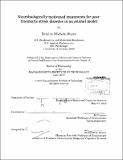| dc.contributor.advisor | Ki Goosens. | en_US |
| dc.contributor.author | Meyer, Retsina Michele | en_US |
| dc.contributor.other | Massachusetts Institute of Technology. Department of Brain and Cognitive Sciences. | en_US |
| dc.date.accessioned | 2013-10-24T17:30:53Z | |
| dc.date.available | 2013-10-24T17:30:53Z | |
| dc.date.copyright | 2013 | en_US |
| dc.date.issued | 2013 | en_US |
| dc.identifier.uri | http://hdl.handle.net/1721.1/81579 | |
| dc.description | Thesis (Ph. D.)--Massachusetts Institute of Technology, Dept. of Brain and Cognitive Sciences, 2013. | en_US |
| dc.description | Cataloged from PDF version of thesis. | en_US |
| dc.description | Includes bibliographical references. | en_US |
| dc.description.abstract | This thesis demonstrates that chronic immobilization stress administered to rats enhances fear learning and increases plasma acylated ghrelin. This effect is independent of the hypothalamus-pituitary-adrenal (HPA) axis since it was unaffected by prior bilateral adrenalectomy. Chronic exposure to a ghrelin receptor agonist, without stress, enhanced associational fear learning without altering HPA hormone levels. This effect was replicated by repeated direct infusions of a ghrelin receptor agonist in the basolateral amygdala (BLA), a brain region involved in emotional memory and altered by stress, suggesting a direct action of ghrelin at ghrelin receptors in the BLA. Administration of a ghrelin receptor inverse-agonist concurrent with stress exposure prevented stress-induced enhancement of fear learning. Other forms of chronic stress increase plasma acylated ghrelin as well, suggesting ghrelin is a novel mediator of long-term stress and a causal agent for stress-increased fear. Furthermore, this thesis identifies patterns in stress-induced feeding changes and body weight alterations that may offer an etiological explanation of the recruitment of the ghrelin pathway during periods of chronic stress. The final scientific chapter of this thesis describes a non-pharmacological intervention to enhance extinction of learned fear. In this work, optimization of extinction training yields resistance to spontaneous recovery of fear and demonstrates a weakening of potentiated synapses in the amygdala after optimal, but not suboptimal, behavioral extinction training. | en_US |
| dc.description.statementofresponsibility | by Retsina Michele Meyer. | en_US |
| dc.format.extent | 226 p. | en_US |
| dc.language.iso | eng | en_US |
| dc.publisher | Massachusetts Institute of Technology | en_US |
| dc.rights | M.I.T. theses are protected by
copyright. They may be viewed from this source for any purpose, but
reproduction or distribution in any format is prohibited without written
permission. See provided URL for inquiries about permission. | en_US |
| dc.rights.uri | http://dspace.mit.edu/handle/1721.1/7582 | en_US |
| dc.subject | Brain and Cognitive Sciences. | en_US |
| dc.title | Neurobiologically-motivated treatments for post-traumatic stress disorder in an animal model | en_US |
| dc.title.alternative | Role of acylated ghrelin in an animal model of post-traumatic stress disorder | en_US |
| dc.type | Thesis | en_US |
| dc.description.degree | Ph.D. | en_US |
| dc.contributor.department | Massachusetts Institute of Technology. Department of Brain and Cognitive Sciences | |
| dc.identifier.oclc | 858803731 | en_US |
